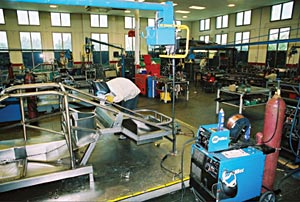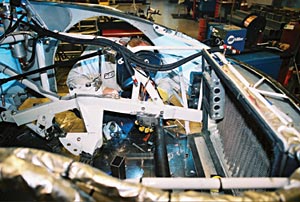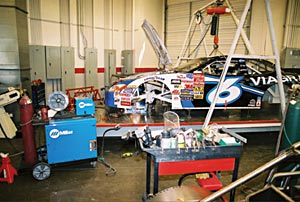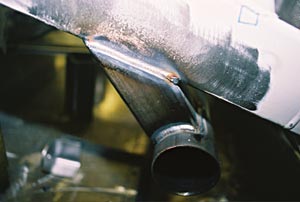For some people, professional stock car racing is a sport or hobby, something fun to do on weekends in summer. But for those who work in the racing industry, it's a business, and the winners are the ones who run it like a business.
That describes Roush Racing, which won its first Winston Cup Series title in 2003 when Matt Kenseth, a native of Cambridge, Wis., drove the no.17 DeWALT Ford Taurus into the winner's circle.
 |
| Miller's CP-302 MIG power source is designed for high production manufacturing lines, which makes it ideal for Roush Racing's chassis shop. The CP-302 industrial three-phase machine is invaluable because of the great number of arc starts and stops involved in fabricating a race car. |
But Roush Racing is hardly a newcomer to success in the racing industry 24 national championships, titles in all of NASCAR's top racing series and 10 straight 24 Hours of Daytona Sedan Class Championships. Nextel Cup Series drivers for Roush include Mark Martin (No. 6), Jeff Burton (No. 99), Kurt Busch (No. 97), Greg Biffle (No.16), and Kenseth. Carl Edwards (No. 99) and Jon Wood (No. 50) are young up and comers currently in the Craftsman Truck Series.
Roush Racing is the pride and joy of legendary owner Jack Roush, who is chairman of the board of Roush Enterprises, the parent company of Roush Racing, Roush Industries, Roush Performance and Roush Manufacturing. The Roush companies have more than 2,000 employees in facilities throughout North America and Europe.
Roush started out as an engineer for the Ford Motor Company in 1964 but soon left to pursue his dual passion for engine development and motorsports. He eventually formed Jack Roush Performance Engineering (later Roush Industries) in 1976 and Roush Racing in 1984. Aside from his business acumen, Roush was the only professional drag racer to venture into every venue of sports car road racing and oval racing. And he was successful in each forum.
Roush likes to win, and he knows that success means never settling for second best. He runs each of his units like a business and expects his managers to make decisions that result in a profitable bottom line. And when they do, he rewards them handsomely.
Team Miller
Nowhere is Roush's business philosophy more evident than in Roush Racing's shop just outside Charlotte, N.C. It looks and operates just like an industrial production facility, which is exactly what it is. And when it came to selecting the welding equipment to help build the cars for Roush's various teams, Roush Racing picked Miller.
For MIG welding in the chassis shop, Roush uses the CP-302 and Deltaweld® MIG power sources paired with Swingarc™ boom-mounted versions of Miller's 60 and 70 series wire feeders. Roush also uses XMT® 304 multiprocess machines.
 |
| Miller's 70 Series Swingarc boom-mounted feeders, 22A benchtop feeders and CP-302 MIG welders allow Roush Racing fabricator T.J. Hamilton the freedom to work efficiently. |
"We build light, fast race cars, and we feel that the Miller equipment is what we need to accomplish our goal," says Dave Dunlap, chassis shop manager. "We feel it's second to none."
Roush Racing prefers to fabricate its cars from scratch, which is why the chassis shop is outfitted with the latest in industrial-quality equipment. "We feel we get a better handle on the chassis once we fabricate it ourselves, and it gives us better control. And to repeat the same process over and over, it's just easier to manage it this way," Dunlap explains.
He points out employees in the chassis shop are professionals who have worked at other chassis manufacturers. "They know how to build the cars and how our people want them built based on input from the crew chief and the driver. This department is run like a business and it shows a financial statement every month detailing its income and expense."
Dunlap says he selected Miller's industrial-quality welding equipment because "our manufacturing process demands that type of machine, and we want to be as efficient as we can."
Efficient and Productive
CP-302 and Deltaweld 302 power sources are designed for high duty cycle applications, which makes them ideal for high production manufacturing lines. They both feature solid-state controls. Compared to machines that use single-phase input power, these industrial three-phase machines deliver excellent heat consistency, steadier wire feed speed, crisper starts and lower spatter. That helps the welds come out smoother with less clean up. Dunlap says the industrial machines are invaluable because of the number of arc starts and stops involved in fabricating a race car.
"Our operators are constantly spot welding, and a non-industrial machine could start to develop contactor problems, or you would need to rotate that equipment out faster because it wears out," he says. "Nobody has ever really counted the number of welds on one of these cars, but you can
't swing a 12-inch tape measure anywhere in our cars without hitting a weld."
 |
| Mark Martin's #6 car gets some fine-tuning in the chassis shop at Roush Racing. Miller's CP-302 power source is the MIG welder of choice. |
Dunlap and his crew are particularly pleased with the Swingarc boom- mounted wire feeders. The chassis shop has five 16-foot booms, and they make a critical difference because they bring an extra dimension of flexibility, efficiency and operator comfort to the welding stations. The Swingarc places the feeder controls at the base of a 16-foot boom and the drive assembly at the end of the boom. The boom rotates 360 degrees and moves 60 degrees up and down to create a 32-foot diameter work area. A counterbalance design holds the boom in place once the operator sets its position.
"Sometimes we're in a bit of a rush because a car got wrecked at the past weekend's race and they want to run it next week. The boom makes us more efficient because it eliminates the need to drag the machines around, which is time-consuming. And we can take two or three booms and work on both ends of the car at the same time and turn the car back to the team faster," Dunlap says.
A side benefit is that the Swingarc removes unwanted cable clutter from the floor, giving the shop cleaner work spaces, less repair to welding cables and a more professional look. "I would encourage anybody who's doing this kind of work that they go with the boom because it's far better in terms of efficiency, cleanliness and the way the area looks," Dunlap adds.
MIG Process Preferred
Dunlap explains that the structural part of each car - the frame and chassis - is MIG welded because it's a faster process. "With the amount of cars we have to move through here, MIG has proven to be strong and reliable. The equipment is durable and it's quick. The operators like it because it's easy to use. However, a lot of the subcomponents that get mounted to the chassis, like the A-frames, spindles and brake brackets, are all TIG welded. It just depends on the application," he says.
Roush Racing builds about 40 new cars each year, and each chassis takes 170 man-hours to produce. Cars-in-the-making are placed on plates, or platforms, where they are worked on by the operators (the plates are level and hold tolerances within one ten-thousandth of an inch). There are four dedicated Nextel Cup plates and a dedicated truck plate where only trucks are built. Fixtures and components for the cars and trucks fit all the plates. "If we have a damaged car or need to make a modification between races, we'll put the car up on a plate and pull out our plan showing the way it was built, with ride heights, pick-up points and stuff like that. And we can check out the chassis to determine whether it needs something replaced or if it's not hurt at all," Dunlap says.
 |
| Roush Racing fabricates most of its parts from scratch, including this front sway bar tube. The tube prevents the race car from rolling. The textbook weld is the result of Miller's CP-302 power source, which produces smoother welds with less cleanup. |
Wrecks and modifications get priority because the team wants to race the car again as quickly as possible.
Like Assembly Line
The majority of the tubing used by Dunlap crew is 1.75-inch outside diameter seamless tubing for the car's main cage and square tubing for the frame rails. "The tubing has .090-inch wall thickness. A mil-spec piece of tubing may come .103 or .104, but we go the extra step of grinding the tube down to make it perfectly conform to the racing industry spec rule, .090-inch wall thickness," Dunlap says.
He explains that once the tubing is in the shop, "we'll take an order from the crew chief as to what he wants in terms of center of gravity or frame rail height, items like that, and then we'll build the chassis. We'll have pre-bent tubing for that particular cage and the front and rear clips are already made on a fixture, so it comes together just like an assembly line. We don't build everything from scratch from the minute we get the order. Some pieces are already built. They may be stamped, they may be welded, they may be just bent tubing, but it's like a kit, and once we get the order we'll assemble the car with the kit."
After an order comes in, fabrication of the main frame begins. "We'll start with the main frame on the desired height of the car and do the center part of the main frame, the tubing, the notched-out part for the drive shaft. And once those components are in place, then we'll attach the front subsection and the rear tail clip with all its components added to it. That makes it a much more efficient process, and takes a lot less time to do it," Dunlap says.
Given that the chassis shop has just 10 welding operators, efficiency and productivity indeed are the bywords at Roush Racing. And that's why it's so important to maintain a businesslike approach.
"Our guys know when they have to have the car done. They know the time frame because the manager and the crew chief have sat down with them and built a plan detailing when they want to run the car. They back-track based on how much time they need, once the chassis is done, to take the car to the race track. This department has to be efficient because it has to meet the deadlines that the crew chief wants for the performance of the team," Dunlap says.
Second best isn't quite good enough at Roush Racing, whether you're talking about racing cars or the equipment that helps build them.